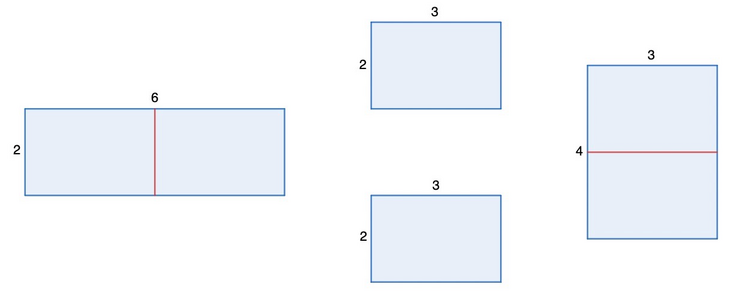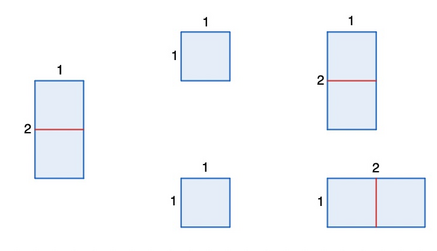Codeforces Round 924 (Div. 2)[A-D]
进算竞小群加我
A. Rectangle Cutting
Bob 有一个大小为 $a \times b$ 的矩形。他试图通过平行于原始矩形的一条边进行切割,将该矩形切割成两个边长为整数的矩形。然后鲍勃尝试从两个生成的矩形中形成一些其他矩形,并且他可以根据自己的意愿旋转和移动这两个矩形。
请注意,如果两个矩形仅相差 $90^{\circ}$ 旋转,则它们被视为相同。例如,矩形 $6 \times 4$ 和 $4 \times 6$ 被认为是相同的。
这样,由 $2 \times 6$ 矩形可以组成另一个矩形,因为它可以被切割成两个 $2 \times 3$ 矩形,然后用这两个矩形可以组成 $4 \times 3$ 矩形,这与 $2 \times 6$ 矩形不同} 长方形。

然而,从 $2 \times 1$ 矩形不能形成另一个矩形,因为它只能被切割成两个 $1 \times 1$ 矩形,并且由此只能形成 $1 \times 2$ 和 $2 \times 1$ 矩形,这被认为是相同。

帮助鲍勃确定他是否可以获得其他矩形,或者他是否只是在浪费时间。
枚举所有的可能,看一下方案数
https://codeforces.com/contest/1928/submission/245800061
// Codeforces - Codeforces Round 924 (Div. 2) A. Rectangle Cutting
// https://codeforces.com/contest/1928/problem/0 2024-02-11 17:36:03
#include <bits/stdc++.h>
using namespace std;
#define all(a) begin(a), end(a)
#define int long long
int n, m;
using pii = pair<int, int>;
template <class T, class U>
ostream &operator<<(ostream &os, const std::pair<T, U> &p) {
os << "" << p.first << " " << p.second << endl;
return os;
}
void solve() {
cin >> n >> m;
set<pii> S;
if (n > m) swap(n, m);
S.emplace(n, m);
if (n % 2 == 0 or m % 2 == 0) {
if (n % 2 == 0) {
S.emplace(min(n / 2, 2 * m), max(n / 2, 2 * m));
}
if (m % 2 == 0) {
S.emplace(min(m / 2, 2 * n), max(m / 2, 2 * n));
}
if (S.size() >= 2)
cout << "Yes\n";
else
cout << "No\n";
} else
cout << "No\n";
}
signed main() {
ios::sync_with_stdio(false);
cin.tie(0), cout.tie(0);
int __;
cin >> __;
while (__--) solve();
return 0;
}
B. Equalize
Vasya 有两个爱好 - 向数组添加排列 $^{\dagger}$ 和查找最常出现的元素。最近,他发现了一个数组 $a$ ,并决定在对数组 $a$ 添加一些排列后,找出与数组 $a$ 中相同数量的元素的最大数量。
更正式地说,Vasya 必须恰好选择一种长度为 $n$ 的排列 $p_1, p_2, p_3, \ldots, p_n$ ,然后根据规则 $a_i := a_i + p_i$ 更改数组 $a$ 的元素。之后,Vasya 计算每个数字在数组 $a$ 中出现的次数,并取这些值中的最大值。你需要确定他可以获得的最大值。
$^{\dagger}$ 长度为 $n$ 的排列是由 $n$ 个从 $1$ 到 $n$ 的不同整数以任意顺序组成的数组。例如, $[2,3,1,5,4]$ 是排列,但 $[1,2,2]$ 不是排列( $2$ 在数组中出现两次), $[1,3,4]$ 也不是排列( $n=3$ 但数组中有 $4$ )大批)。
每个测试由多个测试用例组成。第一行包含一个整数 $t$ ( $1 \leq t \leq 2 \cdot 10^4$ ) - 测试用例的数量。然后是测试用例的描述。
每个测试用例的第一行包含一个整数 $n$ ( $1 \le n \le 2 \cdot 10^5$ ) - 数组 $a$ 的长度。
每个测试用例的第二行包含 $n$ 个整数 $a_1, a_2, \ldots, a_n$ ( $1 \le a_i \le 10^9$ ) — 数组 $a$ 的元素。
保证所有测试用例的 $n$ 之和不超过 $2 \cdot 10^5$ 。
滑动窗口
https://codeforces.com/contest/1928/submission/245810883
// Codeforces - Codeforces Round 924 (Div. 2) B. Equalize
// https://codeforces.com/contest/1928/problem/B 2024-02-11 17:38:48
#include <bits/stdc++.h>
using namespace std;
#define all(a) begin(a), end(a)
#define int long long
int n, m;
void solve() {
map<int, int> mp;
cin >> n;
int _n = n;
set<int> S;
vector<int> a(n);
for (int i = 0; i < n; i++) cin >> a[i], S.emplace(a[i]);
sort(all(a));
vector<int> _a;
n = S.size();
for (auto i : S) _a.emplace_back(i);
int ans = 0;
for (int i = 0; i < n; i++) {
ans = max(ans, upper_bound(all(_a), _a[i] + _n - 1) - (begin(_a) + i));
}
cout << ans << "\n";
}
signed main() {
ios::sync_with_stdio(false);
cin.tie(0), cout.tie(0);
int __;
cin >> __;
while (__--) solve();
return 0;
}
C. Physical Education Lesson
在一所著名的学校里,有一节体育课。像往常一样,每个人都排成一排,并被要求站在 “第 $k$ 个 “的位置上。
众所周知,在 “第一个- $k$ /-第三个 “位置落座的情况如下:第一个 $k$ 人的号码是 $1, 2, 3, \ldots, k$ ,接下来的 $k - 2$ 人的号码是 $k - 1, k - 2, \ldots, 2$ ,接下来的 $k$ 人的号码是 $1, 2, 3, \ldots, k$ ,以此类推。这样,每隔 $2k - 2$ 个位置就重复一次结算。结算示例见 “注释 “部分。
男孩瓦夏经常忘记所有事情。例如,他忘记了上面描述的数字 $k$ 。但是他记得他在队伍中的位置,以及他在结算时得到的数字。请帮助瓦夏理解在给定的限制条件下,有多少个自然数 $k$ 符合要求。
请注意,当且仅当 $k > 1$ 存在时,结算才存在。特别是,这意味着 $k = 1$ 不存在结算。
每个测试由多个测试用例组成。第一行包含一个整数 $t$ ( $1 \leq t \leq 100$ ) — 测试用例的数量。接下来是测试用例的描述。
每个测试用例的唯一行包含两个整数 $n$ 和 $x$ ( $1 \le x < n \le 10^9$ ) - Vasya 在该行中的位置以及 Vasya 在结算过程中收到的数字。
分为两种情况
- 上坡
$n-x$ 代表着 $z(2k-2)$
$k\ge x$
$n-x=z(2k-2)$
$x=n-z(2k-2)$
$n-z(2k-2)\le k $
$z$ 是 $n-x$ 的因子
可以 $O(\sqrt {n-x})$ 时间内枚举完成
枚举$z∈(n-x)_{因子}$
满足
$x=n-z(2k-2)$
$2k-2=\frac {n-x} z$
$k=\frac {\frac {n-x} z +2} 2$
$k=\frac {n-x} {2z} +1$
$n-z(2k-2)\le k $
- 下坡
$n+x-2$代表着 $z(2k-2)$
$k \ge x$
$n+x-2=z(2k-2)$
枚举$z∈{(n+x-2)}_{因子}$
可以$O(\sqrt {n+x-2})$ 枚举 $z$
$2k-2=\frac {n+x-2} z$
$k=\frac {n+x-2} {2z} +1$
$k \ge x$
code
Submission #245962526 - Codeforces
// Codeforces - Codeforces Round 924 (Div. 2) C. Physical Education Lesson
// https://codeforces.com/contest/1928/problem/C 2024-02-12 16:45:22
#include <bits/stdc++.h>
using namespace std;
#define all(a) begin(a), end(a)
#define int long long
int n, x;
vector<int> divide2(int x) {
vector<int> ans;
for (int i = 2; i <= x / i; i++)
if (x % i == 0) {
ans.push_back(i);
if (i * i != x) ans.push_back(x / i);
}
if (x > 1) ans.push_back(x);
return ans;
}
void solve() {
cin >> n >> x;
auto it = divide2(n - x);
it.emplace_back(1);
set<int> S;
for (auto z : it) {
if ((n - x) % (z * 2) == 0) {
int k = (n - x) / z / 2 + 1;
if (k >= x and k >= 2) S.emplace(k);
}
}
auto it2 = divide2(n + x - 2);
it2.emplace_back(1);
for (auto z : it2) {
if ((n + x - 2) % (2 * z) == 0) {
int k = (n + x - 2) / z / 2 + 1;
if (k >= x and k >= 2) S.emplace(k);
}
}
cout << S.size() << "\n";
}
signed main() {
ios::sync_with_stdio(false);
cin.tie(0), cout.tie(0);
int __;
cin >> __;
while (__--) solve();
return 0;
}
D. Lonely Mountain Dungeons [三分]
曾经,中土世界的人民、精灵、矮人和其他居民聚集在一起,想要夺回被史矛革偷走的宝藏。以这个伟大目标的名义,他们团结在强大的精灵蒂莫西周围,开始策划推翻孤山的统治者。
中土居民的军队将由几个小队组成。众所周知,每对处于不同小队的同一种族的生物,都会为军队的总兵力增加 $b$ 个单位。但由于蒂莫西很难领导一支由大量小队组成的军队,因此由 $k$ 个小队组成的军队的总兵力会减少 $(k - 1) \cdot x$ 个单位。请注意,军队始终由至少一个小队组成。
已知中土世界有 $n$ 个种族,第 $i$ 个种族的生物数量等于 $c_i$ 。帮助中土世界的居民确定他们可以组建的军队的最大兵力。
输入
每个测试由多个测试用例组成。第一行包含一个整数 $t$ ( $1 \le t \le 2 \cdot 10^4$ ) — 测试用例的数量。测试用例的描述如下。
每个测试用例的第一行包含三个整数 $n$ 、 $b$ 和 $x$ ( $1 \le n \le 2 \cdot 10^5$ 、 $1 \le b \le 10^6, 0 \le x \le 10^9$ ) — 比赛数量以及上述常量 $b$ 和 $x$ 。
每个测试用例的第二行包含 $n$ 个整数 $c _ 1, c _ 2, \ldots, c _n$ ( $1 \le c _ i \le 2 \cdot 10^5$ ) — 每个 $n$ 种族的生物数量。
确保所有测试用例的值 $c _ 1 + c _ 2 + \ldots + c _ n$ 之和不超过 $2 \cdot 10^5$ 。
Expand
通过观察题意可以了解
当队列数确定了,那么 所有的分配都是 确定 的
所以 存在 一个最优的 队列数 $x$
我们设 $x$ 为最优的 答案
有个单调性
观察 答案与 变量的 关系可以发现是一个凸函数
所以我们可以在函数上跑一个三分
剩下一个稍微难点的地方就是求组合数了
正难则反,所以我们 求出所有的 组合数
再减去不能组合的配对
那么就是每一队列中的不能配对
然后就很好做了
code
Submission #245968550 - Codeforces
// Codeforces - Codeforces Round 924 (Div. 2) D. Lonely Mountain Dungeons
// https://codeforces.com/contest/1928/problem/D 2024-02-12 17:22:54
#include <bits/stdc++.h>
using namespace std;
#define all(a) begin(a), end(a)
#define int long long
int n, b, x;
template <typename... Args>
void debug(Args &&...args) {
((cerr << args << " "), ...), cerr << "\n";
}
void solve() {
cin >> n >> b >> x;
int ans = LLONG_MIN;
vector<int> c(n);
for (auto &i : c) cin >> i;
int l = 1LL, r = 2E5 + 1LL;
auto check = [&](int k) -> int {
int res = 0LL;
for (auto it : c) {
if (it <= k) {
res += (it) * (it - 1LL) / 2LL;
} else {
int avg = it / k;
int mod = it % k;
res -= mod * (1LL + avg) * (avg) / 2LL;
res -= (k - mod) * (avg) * (avg - 1LL) / 2LL;
res += (it) * (it - 1LL) / 2LL;
}
}
res *= b;
res -= (k - 1LL) * x;
return res;
};
while (l < r) {
int lmid = l + (r - l) / 3LL;
int rmid = r - (r - l) / 3LL;
if (check(lmid) <= check(rmid))
l = lmid + 1;
else
r = rmid - 1;
}
cout << max(check(l), check(r)) << "\n";
}
signed main() {
ios::sync_with_stdio(false);
cin.tie(0), cout.tie(0);
int __;
cin >> __;
while (__--) solve();
return 0;
}

